The purpose of this Lessons Learned and Best Practice circular is to assist operators and crew in appreciating the benefits of regular Mooring Winch Brake Rendering Testing, and also share some of the common misunderstandings we have observed.
Although Mooring Winch Render Testing has been established practice in the tanker industry for many years, we are seeing more and more bulk terminals (particularly for Iron Ore and Coal exports) requesting that vessels calling at their terminals undertake periodic testing as per tanker practice.
It is interesting to note that based on investigation of incidents from Western Australian ports, that a frequent cause of mooring line failure is incorrect or non-existent mooring winch brake render testing. With every mooring line parting there is always potential to cause serious harm or death to personnel.
What is render testing?
Render testing is a periodic load test and calibration of a mooring winch brake at a load based on the Equipment Number (EN) assigned to the ship.
Why do we render test?
When moored, winch brakes and lines are expected to keep the vessel safely alongside. When environmental parameters change due to factors such as wind, current, swell, passing vessel surge, excessive list and trim, the winch brakes should be set as the weakest point of the mooring system. Rather than parting mooring lines or damaging mooring winch structures and fittings, the winch brakes should render so that the vessel can be brought back alongside safely. Conversely the vessel should not move away from the berth due to the effect of external forces less than the EN parameters.
Regular winch brake render testing and calibration should significantly contribute to safe mooring.
What are the key design parameters that must be considered?
When a vessel is moored the winch brakes and lines are so designed to keep the vessel safely alongside within certain environmental parameters. Each vessel at the design stage is assigned an “EN” (Equipment Number / Numeral) by Class. The EN sets a Ship Design Minimum Breaking Load (SDMBL) which then determines minimum requirements for Mooring Winch Heaving Speed, Brake Holding Capacity, Mooring Rope Minimum Breaking Load and the Minimum Number of Mooring Ropes.
The Ship Design MBL (SDMBL) should be the initial reference for the Brake Holding Capacity (BHC) tests. When a ship is built, the mooring winches are equipped with mooring lines of an MBL roughly equal to the SDMBL. In cases where a greater strength line is used, the Line MBL can be higher than the Design MBL but must always be less than the mooring fittings (bollards, chocks etc.) SWL values.
It is imperative therefore, that Brake Holding Capacity test calculations must be based on the SDMBL and not the Line MBL.
The table below demonstrates the relationship between SDMBL and Mooring Lines and Fittings and Operational Values:
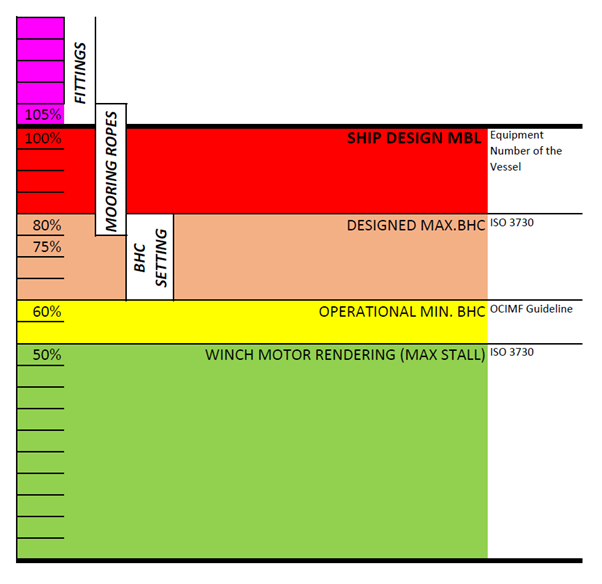
The tanker industry recommends that the Brake Holding Load (ie render setting) be set at 60% of the SDBML which corresponds to the Operational Minimum Brake Holding Capacity in the diagram above.
How is render testing performed?
A test kit should be provided on board by the ship builder or by the Mooring Winch manufacture along with full instructions.
Testing should be carried out under the supervision or in the presence of a responsible person familiar with the operation of the winches, the test procedure and the ship's Safety Management System.
Before testing a winch brake, the condition of the brake, its mechanism and the brake drum should be confirmed as satisfactory. Any damage, failure or excessive wear should be rectified before testing takes place.
It is strongly recommended that ship-specific instructions developed by the vessel’s Technical Managers are on board.
The test itself is essentially a jacking test against the winch brake.
When testing, the aim is to apply a hydraulic force to the winch drum equivalent to the 60% of the SDMBL on the first layer of the rope (for split drum winches) and to ensure that winch brake slips (or renders) at that point. Then, the tightened brake screw must be marked at the point it slips.
It is not a load test to determine how strong the winch brake is, but a test to see that brake holds until 60% of the SDMBL. Applying more force causes slippage of the brake to ensure that winch brake remains the weakest point of the mooring system.
One common mistake when calculating the required hydraulic jack pressure, is that Line MBL is used as the reference rather than SDMBL.
Another common mistake is that when the calculated hydraulic jack pressure is reached and brake is still holding, that the test is deemed successful. It must be clearly seen that after exceeding the calculated limit, the brake slips.
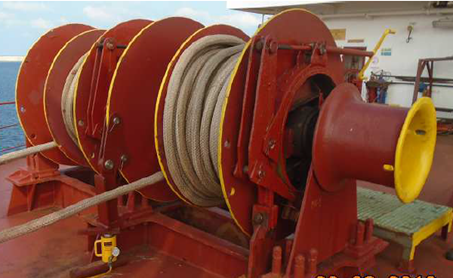
Split Drum Mooring Winch with Test Equipment in Place.
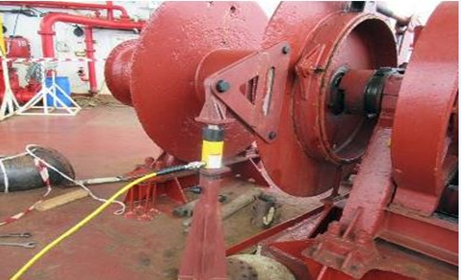
Undivided Drum Mooring Winch with Test Equipment in Place.
Does this differ for winch type?
It is of utmost importance that the correct calculation is used for the type of mooring winch being tested.
Split Drum Mooring Winches must use the calculation based on one layer of line on the tension side of the split drum, such as to replicate a normal moored condition of maximum one layer of rope on the tension drum.
Undivided (ie single drum) Mooring Winches become a bit more difficult and it is recommended that the manufacturers be consulted in terms of how many line layers should be used in the calculation. This may require ship operational experience input to determine the normal number of line layers on the drum during normal mooring configurations.
One common mistake is using a Split Drum calculation (based on one layer of line) when testing an Undivided Drum, the effect of doing this is that rendering will occur at 11% less force for a second layer of line and 25% less force for a fourth layer of line. This can be visualised in the Force / Lever diagram (below):
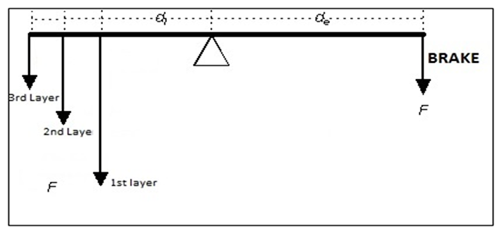
Marking
When the test is completed and the brake setting calibrated, the winch will need to be marked with a marking device to ensure that the brake is applied to the same torque at every mooring operation.
The marking device should be so designed such that further tightening in emergency situations is not impeded, and of suitable construction to remain in position and good condition between routine tests. Examples of unacceptable and acceptable marker designs are shown below:
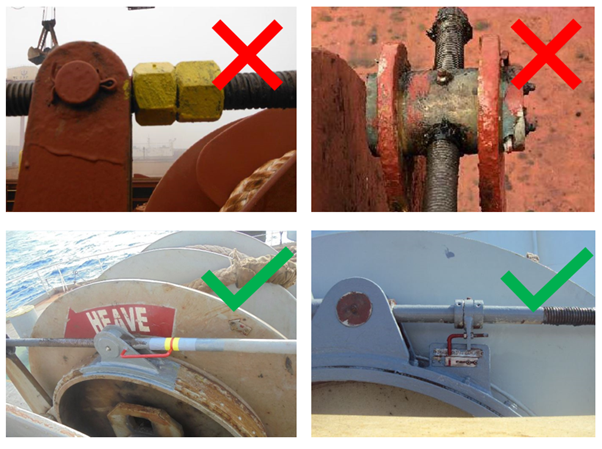
Frequency
The mooring winch brake rendering test should be carried out at intervals more frequently than only once every five years, preferably on an annual basis, and:
- After completion of any modifications or major maintenance such as but not limited to, brake liner renewal, brake band adjustments etc.
- Where there is evidence of premature brake slippage or related malfunctions / mooring incidents
- Installation of new mooring lines which have a different diameter to that used at the last render test.
Training
Procedures for testing mooring winch brakes, including a risk assessment should be made available on board and ship’s crews must be provided with appropriate training to conduct the test safely.
Training must at least cover below;
- What is the relation between Brake holding limit and mooring equipment?
- Why BHC Testing is important for safe mooring operations?
- Why BHC marking reference is important and how it must be used?
- What is the importance of mooring line layers on split drum winches?
- What are the risks of over tightening or less tightening the winch brakes?
Training should be carried out at regular intervals in order to familiarize all crew responsible for mooring.
FAQ’s
- Where do I find the SDMBL for my vessel?
This should be stated on the Mooring Arrangement Plan. If it is not (as may sometimes be the case for older vessels), then it is recommended that you consult with the vessel’s Classification Society.
- What is the difference between the Maximum Brake Holding Capacity and the Operational Minimum Brake Holding Load?
The Maximum Brake Holding Capacity (normally set at 80% of the SDMBL) is the designed maximum holding of the winch brake whereas the Operational Minimum Brake holding Load (normally set at 60% of the SDMBL) is the normal operating Brake Holding (or rendering) Load.
- Why is SDMBL as the governing reference and not Line MBL?
The SDMBL is a fixed parameter derived from the EN and cannot be readily altered whereas lines can conceivably be fitted with MBL’s that differ from those required by the EN.
- Do I need to re-test and re-mark the BHC after changing lines or brake linings ?
Re-testing and re-marking would be required if brake linings are changed or brake drums are skimmed or re-surfaced, however changing lines like for like (ie with same diameter) would not be required. Re-testing is also recommended when brakes have rendered or slipped in service.
- What happens if i tighten the brake more or less than the reference point?
The brake would simply render at unknown lower or higher loads which is undesirable as all winch brakes should be set to render at the same load across the mooring set-up.
- Do i need a third party for regular BHC tests and marking?
No, but it is advisable that the persons conducting the tests are competent, properly trained and provided with ship specific instructions.
- Vessel has single drum winches. How will I determine how many layers of line to be considered for calculations?
For undivided winch drums, it is recommended that the manufacturers be approached for guidance. This may require ship operational experience to identify the normal number of layers in use for most mooring operations.
- I have marked the reference point with a jubilee clip / wire and it has moved. What should I do?
If the reference point marking has moved accidentally (during operation, maintenance, greasing, painting over etc) the test must be carried out again and re marked. Marking should not impede further tightening in case of emergencies and must be clearly visible and fixed such that it does move easily.
- What information should be marked on the winch after the test is completed?
Marking the test date, tested force (in tonnes or KN, same as mooring fitting markings) and respective percentage of the SDMBL (eg. %60) should be marked on the winches.
Abbreviations & Terminology
Further Reference
- OCIMF – Mooring Equipment Guidelines (4th edition)
- ISO 3730:2012 - Shipbuilding and marine structures — Mooring winches
- OCIMF – Effective Mooring (4th edition)
- INTERTANKO – Guidance on Line Management Plans (LMP)
- INTERTANKO – Guidance on Mooring System Management Plans (MSMP)
.webp)